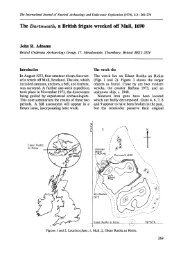port henderson : past & present - Royal Commission on the Ancient ...
port henderson : past & present - Royal Commission on the Ancient ...
port henderson : past & present - Royal Commission on the Ancient ...
Create successful ePaper yourself
Turn your PDF publications into a flip-book with our unique Google optimized e-Paper software.
from <strong>the</strong> sea because <strong>the</strong>re were no roads to <strong>the</strong> fishing village. (It has been suggested by some<br />
residents that <strong>the</strong> kiln was used ei<strong>the</strong>r to burn seaweed for fertiliser or to smoke fish. However, <strong>the</strong>re<br />
are no tarry deposits to be seen which would indicate fish smoking). Between <strong>the</strong> headland of A’<br />
Sgùmán and <strong>the</strong> <str<strong>on</strong>g>port</str<strong>on</strong>g> <strong>the</strong>re was a well, Fuarán a’ Sgùmán, which was said to have <strong>the</strong> finest water in<br />
Port Henders<strong>on</strong>, never to run dry and to be<br />
always cool. This can still be seen. A grassy<br />
area to <strong>the</strong> south of <strong>the</strong> buildings was used<br />
for drying fishing nets. Behind <strong>the</strong><br />
buildings were 'gardens' as laid out in <strong>the</strong><br />
original minutes of sett.<br />
The sec<strong>on</strong>d row of fishermen’s<br />
cottages is found towards <strong>the</strong> main beach<br />
and was called An Càrn Mór, translated as<br />
‘<strong>the</strong> big cairn’, although this name has also<br />
been applied to <strong>on</strong>e house, ‘Carnmore.’ (The original Carnmore burnt down and was rebuilt, see page<br />
78).<br />
To <strong>the</strong> north of <strong>the</strong> township is Lianag na h-Atha, meaning ‘green of <strong>the</strong> kiln’ (OSR) which is a<br />
small <str<strong>on</strong>g>port</str<strong>on</strong>g>i<strong>on</strong> of land where <strong>the</strong>re are <strong>the</strong> remains of two kiln structures. The faint outline of <strong>on</strong>e can be<br />
seen <strong>on</strong> open moorland within croft 20 whilst <strong>the</strong> o<strong>the</strong>r, slightly more distinguishable, is nearer <strong>the</strong><br />
rocky shoreline below croft 13.<br />
Wentworth recorded that <strong>the</strong>re were tracks or pathways which linked Port Henders<strong>on</strong> with <strong>the</strong><br />
next township of Opinan and from <strong>the</strong>re more led to South Erradale but <strong>the</strong>se are now disused and not<br />
easy to discern. The main track from Port Henders<strong>on</strong> to Opinan was where <strong>the</strong> <str<strong>on</strong>g>present</str<strong>on</strong>g> road runs. There<br />
was also a track which cut across rough ground from <strong>the</strong> south of Port Henders<strong>on</strong> to Opinan which can<br />
still be followed and this was used by <strong>the</strong> schoolchildren when <strong>the</strong> school in Opinan was functi<strong>on</strong>ing.<br />
It was very comm<strong>on</strong> for wells to be found in townships. Some were merely springs but o<strong>the</strong>rs<br />
were built with small retaining walls for protecti<strong>on</strong>. One such well can<br />
still be seen with <strong>the</strong> st<strong>on</strong>es in place. It was known locally as Fuaran Aili<br />
Eachainn. Aili Eachainn was <strong>the</strong> name of <strong>the</strong> shoemaker who lived in <strong>the</strong><br />
house at a’ Bhuile Dhubh, <strong>the</strong> ‘black (cattle-) fold’, who used this well.<br />
Aili Eachainn was Alec, s<strong>on</strong> of Hector MacKenzie. From <strong>the</strong> census<br />
records for 1891 and 1901 Alexander is recorded as living in a twowindowed<br />
crofthouse <strong>on</strong> croft 10. His name is also recorded in <strong>the</strong> Opinan<br />
School registrati<strong>on</strong> book as being born <strong>on</strong> August 6 th Port a Sgùmán today<br />
showing ruins of <strong>the</strong><br />
fishermen's houses and<br />
new build<br />
Aili Eachainn's well<br />
1869. Today a few yards below <strong>the</strong> well is a<br />
c<strong>on</strong>crete water tank, now disused, which <strong>on</strong>ce stored <strong>the</strong> well water. There is ano<strong>the</strong>r well to be found<br />
under some overhanging rocks <strong>on</strong> <strong>the</strong> west side of An Sgùmán where <strong>the</strong> women used to wash<br />
blankets. After washing <strong>the</strong>y would spread <strong>the</strong> blankets out to dry <strong>on</strong> <strong>the</strong> slopes. This well was <strong>on</strong>ly<br />
8



